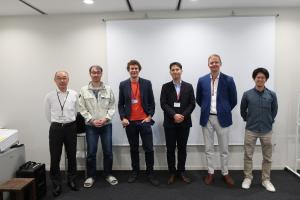Dr. Olivier Pierron G.W. and Dr. Subin Lee will give a lecture at NIMS on June 2, 2025 as the 172th Structural Materials Seminar.
Date: Jun. 2, Mon, 2025. 10:30-11:45
Place : Conference room, 5th floor of advanced structural materials research building, NIMS Sengen site
Title #1: Small-Scale Mechanical Testing with MEMS Devices
Speaker: Dr. Olivier Pierron G.W., Woodruff School of Mechanical Engineering, Georgia, Institute of Technology, Atlanta, GA
Title #2: Insights Into the Grain Boundary Sliding Behavior of Ni Bicrystal Micropillars
Speaker: Dr. Subin Lee, Karlsruhe Institute of Technology (KIT), Germany
Chair: Thomas E. J. Edwards, Mechanical Properties Group

Dr. Olivier Pierron G.W (second from Right), Dr. Subin Lee (Third from Right)
Small-Scale Mechanical Testing with MEMS Devices
Dr. Olivier Pierron G.W., Woodruff School of Mechanical Engineering, Georgia, Institute of Technology, Atlanta, GA
Small-scale mechanical testing has become a critical part of materials research, whether for discovering nanoscale phenomena in modern technological applications or for enabling minimally invasive approaches to collect mechanical data from bulk materials and calibrate / validate advanced models. In this talk, I will present and discuss several advanced, MEMS-based in-situ SEM/EBSD/TEM mechanical testing techniques to investigate the plasticity, creep and fatigue properties of a wide range of materials, including ceramics and metals. Our novel in-situ EBSD/SEM fatigue testing technique allows accelerated fatigue tests (109 cycles in one day) on metallic thin films to investigate fatigue-induced grain growth and the effect of solute segregation on grain size stability in the nanocrystalline regime, to develop fatigue-resistant metals.
Our in-situ TEM technique enables nanoscale observation of defect-defect interactions (including dislocations, grain boundaries, irradiation-induced defects) and their role on deformation, while measuring concomitantly the stress-strain response and other signature parameters such as activation volume. Some of the key issues we are actively investigating with this approach include governing plastic deformation mechanisms in nanocrystalline/ultrafine grained metals, mechanically-induced grain growth and its role on plasticity, mechanical annealing of irradiation-induced damage, and the role of solute segregation on grain boundary stability. I will also discuss a MEMS device (currently in development) to perform in-situ SEM irradiation creep tests, a critical technique to qualify novel structural materials for next generation nuclear reactors.
Insights Into the Grain Boundary Sliding Behavior of Ni Bicrystal Micropillars
Dr. Subin Lee, Karlsruhe Institute of Technology (KIT), Germany
Grain boundary sliding, typically favored at high homologous temperatures and low strain rates, remains poorly understood, particularly regarding its mechanisms, interaction with dislocation slip, and role in plastic deformation. To investigate this, we conducted in situ SEM micropillar compression tests on Ni bicrystals with a high-angle grain boundary (~20°) separating grains oriented near [324] and [344]. Micropillars with diameters of 0.5, 1, and 3 µm were fabricated via focused ion beam milling, with the grain boundary inclined ~35° to the compression axis. We found that sliding initiates at 573 K under strain rates of 10⁻³ to 10⁻² s⁻¹, independent of pillar diameter. Marker line offsets indicated that grain boundary sliding contributes 40–65% of the plastic strain, occurring uniformly during deformation. Significant differences were noted in the sliding behavior of Ni bicrystal micropillars as compared to polycrystalline Ni and the details will be discussed.